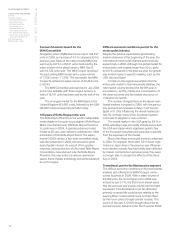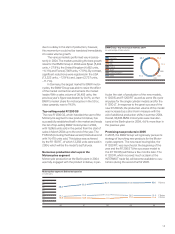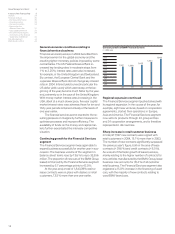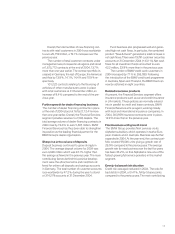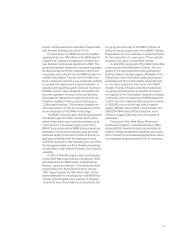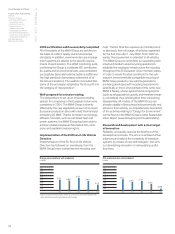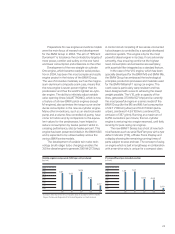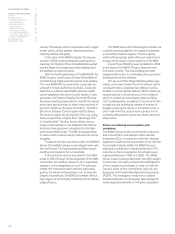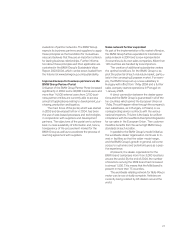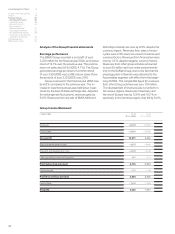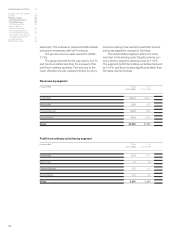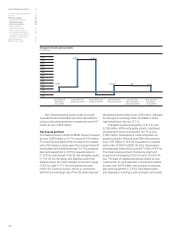BMW 2004 Annual Report Download - page 25
Download and view the complete annual report
Please find page 25 of the 2004 BMW annual report below. You can navigate through the pages in the report by either clicking on the pages listed below, or by using the keyword search tool below to find specific information within the annual report.24
Group Management Report 8
A review of the Financial Year 8
Outlook 29
Financial Analysis 30
--Earnings performance 30
--Financial position 33
--Net assets position 34
--Events after the
Balance Sheet date 37
--Value added statement 37
--Key performance figures 39
--Comments on the financial
statements of BMW AG 40
Risk Management 44
BMW Stock in 2004 48
vehicle.This design, which has proven itself in larger
model series, allows greater steering precision,
tracking stability and agility.
In the case of the BMW 5 Series Touring pre-
sented in 2004, technical features such as active
steering, the Dynamic Drive roll stabilisation system
and the Head-Up-Display have been adapted and
are available as optional extras.
With the fourth generation of the BMW M5, the
BMW Group is continuing a 20 year-old tradition of
manufacturing highly powerful sports-style sedans.
The new BMW M5 is powered by a specially de-
veloped V10 high-performance engine. Gears are
selected via a seven-speed SMG gear-box which
can be adapted to the driver’s exact wishes. A new
generation of Dynamic Stability Control (DSC) has
also been developed specially for the M5; this allows
particularly sporty drivers to select a second level of
dynamic stability at the push of a button. The M5’s
Electronic Damper Control system (EDC) allows
the driver to adjust the driving feel of the car, using
three programmes, ranging from “sportingly firm”
to “comfortable”. Another button allows various
engine characteristics to be displayed. All of these
functions have also been integrated into the high-
performance M6 Coupé. The M6 is equipped with
a carbon roof to reduce weight and lower its centre
of gravity.
Thanks to the new roof construction, the BMW 6
Series Convertible’s shape is very elegant even with
the roof closed. The top provides excellent sound-
proofing and insulation for a convertible.
A second body version was added to the MINI
range in 2004 through the development of the MINI
Convertible. One feature, unique for the convertibles
segment,
is the integrated sun-roof. The fully-auto-
mated roof mechanism also functions particularly
quickly, the whole roof opening in only 15 seconds.
Despite its small size, the MINI Convertible offers a
high degree of
functionality combined with an optimal
usage of space.
The BMW Group and PSA Peugeot Citroën are
currently working together on a project to develop
a new family of petrol engines. These engines,
which will incorporate state-of-the-art engine tech-
nology, will be used in future versions of the MINI.
A new Project Building was completed in 2004
at the heart of the BMW Group’s Research and
Innovation Centre. The new building has been
designed with a view to accelerating the successful
development of new vehicles.
The lay-out of the Project Building allows spe-
cialists and project teams from the various techni-
cal departments, organised according to series
models, to work together directly. Work centres are
located around a central atrium, at the middle of
which is located an oval-shaped, glass building.
This “building within a building” is connected to the
outside circular building by means of a series of
bridges crossing the atrium. It is therefore only a
short walk from the project work-centres to the
central building which serves as a studio and work-
shop centre.
Focus on reducing consumption and
emissions
The BMW Group remains committed to reducing
fuel consumption and related carbon dioxide
emissions (CO2). In conjunction with the voluntary
agreement made by the Association of the German
Automobile Industry (VDA), the BMW Group is
making its contribution towards achieving a 25%
reduction in fleet consumption for vehicles newly
registered between 1990 and 2005. The BMW
Group is also pushing ahead with new light-weight
construction concepts, and with the development
of new engine technologies in order to fulfil the
Group’s share of the commitment given by the
European Automobile Manufacturers Association
(ACEA). This envisages a reduction in carbon
dioxide emissions on a European fleet average for
newly registered vehicles to 140 g/km, equivalent


